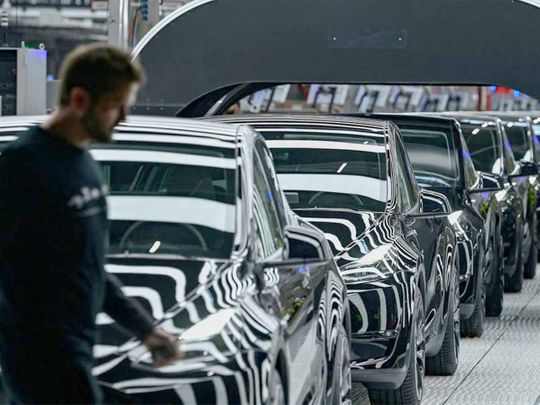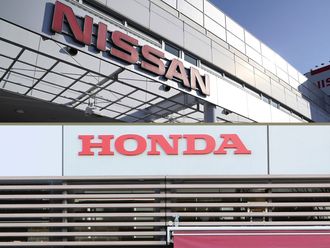
Tesla Inc. missed first-quarter profit estimates after a series of price cuts designed to boost demand squeezed margins.
Revenue rose 24% to $23.33 billion in the quarter, nearly in line with Bloomberg estimates of $23.35 billion. Profit excluding some items fell to 85 cents a share, slightly below the 86-cent average of estimates compiled by Bloomberg, while free cash flow slumped to a two-year low of $441 million.
Analysts had expected free cash flow to reach $3.24 billion in the quarter.
The Austin, Texas-based electric-vehicle maker has been slashing prices to protect its leading market position. Tesla said its operating margin was 11.4% in the three-month period, down from 16% last quarter and 19.2% a year ago.
Unusually, it didn't break out its automotive profit margin, which analysts have been watching closely.
Investors are showing some nervousness about that aggressive pricing strategy. The company's shares slid almost 5%, before paring slightly, in late trading in New York after the results were announced. The stock was up 47% so far this year through Wednesday's close.
"Tesla is going through a rough patch," said Gene Munster, managing partner at Deepwater Asset Management. "They are holding things together, but investors want to see some of these trends start to improve."
Profit Advantage
Tesla's profitability sets it apart from other EV companies. The carmaker downplayed concern about its recent price cuts, saying its margins fell "at a manageable rate." It said higher vehicle deliveries and raw materials costs played a factor in reducing profits.
"Our operating margins remain among the best in the industry," Chief Executive Officer Elon Musk said in a call with analysts.
Tesla has also benefited from tax credits included in the Biden administration's Inflation Reduction Act (IRA). The company reported regulatory credits of $521 million in the first quarter.
Musk has repeatedly said he doesn't mind sacrificing profits to juice demand, arguing the high cost of Tesla cars are holding back potential customers. The base price of the Model 3 has now dipped below $40,000 for the first time in years, a roughly $7,000 cut from the start of the year.
Scaling up production
The CEO is leaning on the fact Tesla can produce electric vehicles at scale to build on an existing lead over competitors, which are rolling out slick new battery powered vehicles. Tesla is working with an older stable of models, having last introduced a new passenger car -- the model Y -- in 2019.
Production of Tesla's long-awaited Cybertruck electric pickup is on track to start later this year at its plant in Texas, with a "delivery event" expect in the third quarter.
The company also is making progress on its next-generation vehicle platform, according to a shareholder letter. Those future product models will be unveiled at a "later date," the company's design chief, Franz von Holzhausen, said at an event last month.
Target: 1.8 million cars this 2023
The EV maker said output this year will meet previous guidance for average annual growth of 50% over multiple years, and said it's on track to deliver about 1.8 million vehicles this year. It produced 440,808 cars and delivered 422,875 vehicles in the quarter, resulting in excess inventory of about 18,000.
Orders are now outpacing production, Musk said on the call.
Tesla's solar deployments plunged in the first quarter, deploying only 67 megawatts, largely due to "volatile weather" and other factors. It installed at least 94 megawatts in each of the preceding three quarters.








